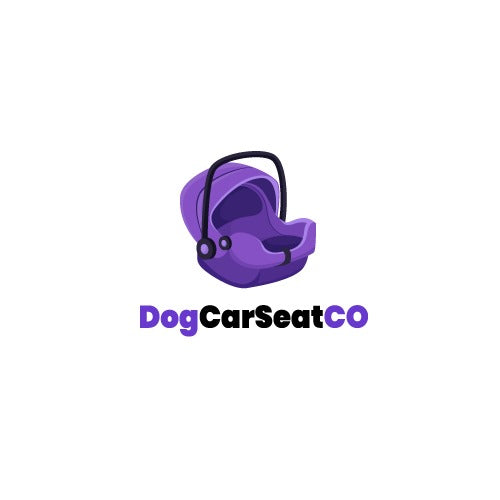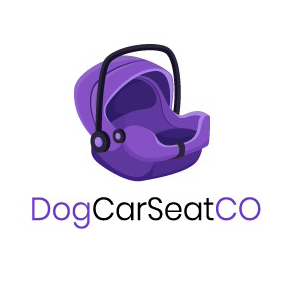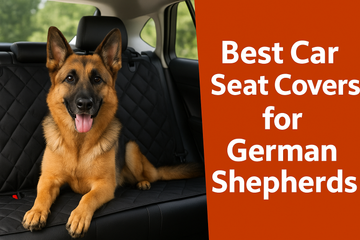
This prevents them from moving around in the car and keeps them safe in case of an emergency or crash. Here's a simple guide on how to buckle up your dog securely. First, choose the right harness for your dog. It's essential to ensure the harness is crash-tested and complies with the Federal Motor Vehicle Safety Standard. Brands like Kurgo offer reliable products, such as the Tru-Fit Enhanced Strength harness, which is specifically designed for dogs up to 75 pounds. Attach the carabiner clip to the car seat belt, ensuring a tight and secure connection. Finally, adjust the harness to ensure a comfortable and snug fit for your dog, using the adjustment points to customize it. For realistic testing, the harness has been thoroughly tested in a University testing facility to ensure its strength and effectiveness in protecting your dog.


Traveling with your dog can be fun, but safety is always the top priority. First, choose the safest dog car seat or dog car seat belt that is appropriate for your dog’s weight and size. For smaller dogs, like a 10-pound pup, a dog car seat may be ideal. Larger dogs, such as an 80-pound dog, may require a dog seat belt to keep them restrained during travel. Make sure to place the dog seat belt or seat in a stable position so it doesn't move around during the ride.
Once your dog is securely in their seat, ensure that they are in a calm position to avoid motion sickness or anxiety. During long-distance travel, pets may experience discomfort, so it's important to provide food and water during stops and take regular potty breaks. The car safety features of your car, such as airbags and seat belts, are designed for humans and can cause trauma to pets in the event of a vehicular accident. A dog car seat or dog car seat belt keeps them restrained, preventing them from becoming a flying projectile during a sudden stop or swerve. Just as humans need protection, our furry companions deserve it too!
Dog Car Seats and Seat Belts: Choosing the Best Option
When it comes to ensuring your dog's safety during travel, dog car seats and seat belts are essential. These products provide a great solution to keeping your pup secure while in the car, especially in the backseat, which is considered the safest place for dogs. Many options available, such as harnesses, carriers, and crates, are designed to keep your pet safe and comfortable while you’re on the road. Choosing the right dog car seat is important, as some options are certified for crash-worthiness and offer superior protection.

3 Steps to Buckle Up Your Dog in the Car
Place the dog car seat in the backseat of your vehicle. This is the safest spot, as the backseat is less likely to be involved in accidents. Ensure the seat is securely fastened using your vehicle's seat belt or other restraints designed specifically for dogs.
Buckling up your dog means using a seat belt or a specialized dog harness that’s designed to be attached to the car’s existing safety system. Make sure the restraint fits well and doesn’t restrict movement, but keeps your dog from jumping or moving around too much.
Always double-check the crash-test-dummy reviews and safety standards of the dog car seat or harness you choose. Look for a product with an official Pet Safety Center approval logo to ensure that it meets the highest crash-test standards for dogs. You can also follow this dog car safety checklist to make sure your pet is protected on every trip.
Choosing Between Dog Car Seats and Seatbelts
When it comes to dog car seats and seatbelts, pet owners have an important decision to make for their furry roommates. While seatbelts with harnesses provide security during travel, a dog car seat offers additional comfort and impact protection. It’s crucial to prioritize safety and comfort to create a secure environment for your pet. Many dog car seats help with the distribution of impact forces, reducing the stress on your dog during sudden stops. Both options have their place, but when choosing between the two, consider whether your pet needs more protection from the forces of travel or if they’ll benefit from a more cushioned experience. Ensuring that your dog feels comfortable while traveling with food and water is just as important as safety. Whether in the UK or elsewhere, it's your responsibility to select the right one for your pet and family.
The Lack of Oversight in Pet Products
The pet industry is booming, with its financial worth increasing every year. However, the rise of products like dog seats and other pet safety products raises concerns about the oversight in place. Many pet products lack proper testing standards to ensure they live up to the safety claims that are often backed by marketing jargon. As pet owners, we need to be cautious about the safety of products that promise to keep our pets secure. Without rigorous testing, some products may not deliver the protection they advertise, leaving pet owners in the dark about whether the product is truly providing the care their pets deserve. For verified and reliable options, explore our dog car seat covers.
The Quest for the Best Dog Car Seats and Restraints
Finding the best dog car seats and restraints requires a deep dive into the testing and safety standards set by organizations like the Center for Pet Safety (CPS). This nonprofit consumer advocacy organization has worked tirelessly to uncover the marketing fiction surrounding pet products. Thanks to the hard work of their founder, Lindsey Wolko, pet owners now have access to rigorous testing data and certification programs that guide them toward products that provide genuine pet safety. With the knowledge they offer, choosing a dog car seat or restraint that prioritizes your pet’s protection is easier than ever. Trusting reliable sources and testing results will help ensure your furry roommate travels safely, without compromising on comfort.
To learn more about the safest ways for your dog to travel in the car, check out this informative guide.
Do Dog Seat Belts Work?
When it comes to traveling with your furry friend, the dog seat belts are a crucial tool for ensuring their safety in the vehicle. Many pet owners might overlook the importance of proper restraints for their dogs during car rides, but in the event of an accident, the risk of injury is just as real for them as it is for us. In the event of a sudden change of speed or a crash, unrestrained dogs can become projectiles, leading to serious injury not only for the pet but also for the driver and passengers. Dog seat belts are designed to keep your dog securely in place, minimizing the risk of distractions that could arise if the dog starts moving around the car. Properly buckle them in, and you’ll avoid the dangers of pulling force from a regular seat belt.


A dog car seat or dog car harness is an essential first step. Make sure to select a dog car seat that is designed for your dog's size. If you're in the UK, various options can help you secure your dog. Whether it’s a dog seat belt that attaches to the harness or a dog car seat that gives them a comfortable and safe spot, you should always ensure the harness fits your dog's chest and back snugly. This minimizes any shifting that could cause injury during a sudden stop or crash.
Once you've chosen the proper dog harness, you need to securely attach the strap to the buckle of the dog seat belt in your vehicle. Make sure the dog's safety is the priority by ensuring the strap is short enough to keep your dog in place but not so tight that it restricts movement. For larger dogs, this can be more challenging, so be sure the harness fits well and that the straps are positioned correctly to avoid pressure on their neck or chest. The goal is to prevent your dog from becoming a dangerous projectile in the event of an accident. Before starting the car, always do a quick check. Ensure that the dog harness is not too loose or too tight. The buckle should be firm, but the harness should also allow your dog some comfort without limiting movement excessively. The straps should allow them to sit or lie down without too much restriction, but should still keep them safe if a crash occurs. Make sure your dog’s back and neck aren’t under undue stress, as a poorly fitted harness can cause injury in the event of a sudden change of speed.
If you have a larger dog, you might be wondering about the best options for their travel comfort and safety. Check out this guide on suggested dog car seats for large dogs for more information.
The AUBELL 3-in-1 Pet Car Seat Belt for Dogs
When traveling with your dog, keeping them safe and secure is crucial. A dog car seat or dog car seat in the UK can make a significant difference, but for the best protection, a seat belt designed for pets is a must. First, choose the right dog seat belt like the AUBELL, 3-in-1 Pet Car Seat Belt. This multifunctional belt has impressive strengths, with a tensile strength of 900 pounds, making it ideal for small dogs and even medium-large dogs. Its adjustable belt strap can be set to 25-32 inches, ensuring your dog is comfortably tethered in the back seat or SUV cargo area without excessive movement.

Next, securely attach the lockable carabiner to the seat belt receiver and adjust the bungee webbing or zipline for extra comfort and shock absorption. This will allow your dog some freedom to move around but prevents them from being a distraction in the car. Lastly, consider the adaptable features such as anchor loops, which help keep the belt tangled-free, ensuring your dog stays safe during long drives or sudden stops. By using these features, your dog can safely lie down, stand up, or even hang out in the back seat while you focus on the road.
How to Keep Your Dog Comfortable During Car Rides
A dog car seat can make all the difference in ensuring your dog is comfortable during long car rides. It's important to familiarize your pet with the dog car seat before the trip, so they feel safe and secure. Always ensure that your dog is properly secured with a seatbelt or in a crate for their safety. Adding familiar items like blankets or toys inside can help keep them calm. Make sure the temperature inside the car is cool and fresh, and if possible, crack open the windows for a breeze of fresh air. Always bring food and water to keep them hydrated, especially if the trip lasts for several hours. It’s essential to limit the time spent in the car to avoid discomfort and to ensure your dog’s well-being throughout the journey. Whether you're using a dog car seat in the UK or elsewhere, providing these essentials can make the ride more enjoyable for both you and your dog.
When planning a car ride with your dog, one essential thing to ensure their comfort and safety is a dog car seat. Not only does it provide a secure place for your dog, but it can also help prevent distractions while you drive. Especially for dogs that get anxious or have trouble staying still, a dog car seat in the UK can be a game-changer. It gives your furry friend a cozy, stable spot and can prevent motion sickness or car sickness. By securing them in a dog car seat, you reduce the chances of your dog becoming unsettled during the ride, making your trip more peaceful. Whether you’re headed on a short trip or a longer road trip, a dog car seat helps keep your dog calm and focused, contributing to a much more pleasant journey for both of you.
How to stop dogs panting in the car?
If your furry companion tends to pant excessively during car rides, one way to help them stay calm is by providing a dog car seat that gives them enough space to sit comfortably. A secure dog car seat in the UK can also ensure that your dog remains in a stable position, reducing the stress that might lead to panting. When dogs feel too cramped or unsafe, they tend to pant more due to anxiety. A well-fitted seat can offer access to a comfortable resting spot and reduce nervousness, which can make a significant difference during long car journeys. Another important factor is ensuring that your dog stays hydrated throughout the ride. Keep fresh water available so they can take water breaks when needed. Being excessively thirsty or dehydrated can lead to excessive panting, so make sure your dog has the chance to drink water whenever possible. These small adjustments can keep your dog calm and help prevent panting from becoming an issue.
How to calm a dog down in a car?
When traveling with your dog, having the right dog car seat can make all the difference. A dog car seat in the UK is designed to keep your dog secure, helping them feel less stressed. The dog car seat provides a safe and comfortable space, reducing the risk of motion sickness and minimizing anxiety during long trips. If your dog has a tendency to get nervous in the car, consider consulting your vet for advice. Sometimes, motion sickness can make the experience worse, and your vet may recommend medication or anti-anxiety medication to help your dog stay calm. Always remember that a secure and cozy seat can also prevent distractions and help your dog feel at ease. A key part of keeping your dog relaxed is ensuring they get plenty of exercise before your trip. A short walk or playtime can help burn off energy, making your dog less anxious during the journey. Additionally, pheromone sprays or diffusers can help create a calming atmosphere in the car. These sprays mimic the comforting scent of a nursing mother dog, which can help your dog relax. If your dog shows signs of stress, a collar with a calming scent or a few spritzes of spray may ease their nerves. Just like humans, adult dogs benefit from an environment where they feel safe and comfortable. For dogs that tend to become overly stressed, a calming spray may be a helpful addition to your travel routine, ensuring a peaceful ride for everyone.
Conclusion:
To ensure your dog's safety and comfort during car trips, using a properly fitted dog car seat or seat belt harness is essential. These products secure your pet, preventing them from becoming a dangerous projectile in case of a sudden stop or accident. The choice between a dog car seat and a seat belt harness depends on your dog's size and comfort needs. Both options help reduce stress and anxiety, especially during long trips, while promoting safety. However, pet owners should prioritize selecting certified, crash-tested products to guarantee reliable protection. Additionally, ensuring regular hydration, breaks, and comfort for your dog will contribute to a more enjoyable journey for both of you.
Frequently Asked Questions.
How do you use a dog car restraint?
To use a dog car restraint, first, ensure the harness fits snugly but comfortably, then attach the carabiner (or tether) to both the shoulder and lap portions of the seatbelt and the harness's back strap, ensuring the seatbelt is buckled and locked.
How to put a belt on a dog?
Here's how to put it on: unbuckle the straps. Place the harness over your pup's head drape the buckles over your dog's body across their midsection. If your harness has a different color strap, like...
How to secure a dog in the car with a leash?
To safely secure your dog in a car using a leash, use a properly fitted harness in combination with a car tether, ensuring it's not too short or too long, allowing the dog to move comfortably.
What are the rules for using restraints?
Restraints should be used only as a last resort. Caregivers in a hospital can use restraints in emergencies or when they are needed for medical care. When restraints are used, they must: Limit only the movements that may cause harm to the patient or caregiver.





